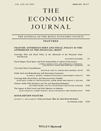-
Views
-
Cite
Cite
P. A. Geroski, C. F. Walters, Innovative Activity over the Business Cycle, The Economic Journal, Volume 105, Issue 431, 1 July 1995, Pages 916–928, https://doi.org/10.2307/2235158
Close - Share Icon Share
Abstract
This paper examines cyclical patterns of innovative activity in the United Kingdom over the period 1948-83. Innovative activity turns out to have many of the properties of a random walk, but does show a tendency to cluster during booms. There is clear evidence of a long-term secular relation between the level of innovative activity and the level of economic activity, although this may have changed in the 1980s. Finally, the data provide no reason for thinking that these clusters of innovation cause cyclic variations in economic activity, but variations in economic activity do Granger cause changes in innovative activity.





